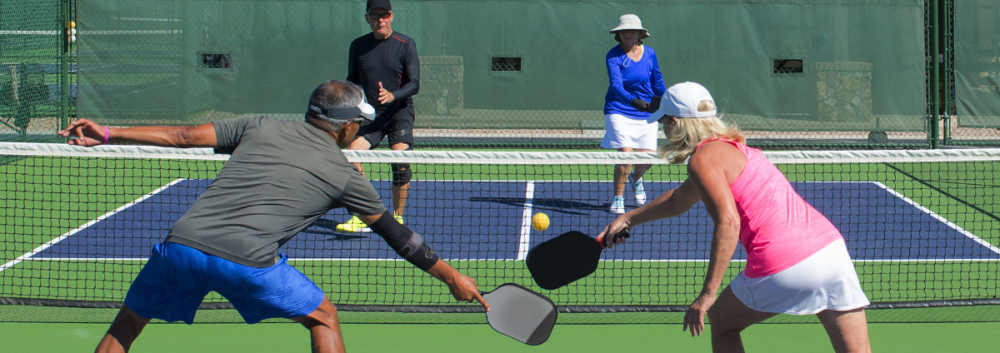We are constantly told by coaches to get to the kitchen line as soon as possible. This is generally good advice. The dominant court position is up at the NVZ line and depending on the skill levels of the competing pairs, the majority of rallies are won from that position. The problem is that the advice can be translated into ‘get to the kitchen line at all costs’. This leads to players running like lemmings to the cliff edge, often with similar consequences. The advice is probably so frequently drilled into players because many beginners and lower intermediates seem very reluctant to go anywhere near the kitchen and often give away easy points by hanging back and leaving large gaps for short and cross court winners.
It is important to recognise that you can’t always get to the kitchen line in one go. This advice is aimed particularly at the serving pair. Normally you would expect the receiving pair to be at their kitchen line already. The receiver’s partner is there from the start and the service receiver will generally play a return deep to the opposing baseline to pin the serving pair at the back of the court and have sufficient time to join their partner at the kitchen.
This is why, for the servings side, there is a great deal of emphasis on the third shot drop. The first shot is the serve, the second shot is the (usually deep) return of serve, the third shot is played by the serving side (usually from the back of the court). By now their opponents will be at their NVZ. The point of the the serving side playing a drop shot at this point is that the ball should land in the kitchen or at least be below net height before it can be volleyed.
What happens next will depend on how good a drop shot it was. It may allow the serving team to get right up to their kitchen, neutralising the advantageous position of the receiving side and initiating a dinking rally. It may be a poor drop and can be attacked with a volley above net height. If so, staying back to defend is likely to be the best option. Or it may be legally volleyed back firmly from at or just below net height and you may have made some progress into the mid court transition zone. One response to this may be to play another drop shot (which is likely to be easier to play since you are closer to the net) and resume your advance to the kitchen line.
The message here is that it is good to be able to play drops shots (sometimes referred to as resets) from anywhere on the court. And this may often mean playing awkward shots from around your feet. The only way to improve your short game is practice, doing drills or doing conditioned games that focus on these shots. You can of course practice these shots in recreational and social play. Just tell your partner what you are doing and why.
Finally, you don’t have to play a third shot drop all the time. A drive down the middle can win a rally or get a weak return against a pair who are not well organised and tend to leave a yawning gap down the middle of the court. Or a drive at the body of your opponent whose reactions are a bit suspect or are holding their paddle too low. Straight at their backhand shoulder can be particularly effective!. If the service receiver is a bit slow coming to the net, hitting the ball back to their feet while they are on the move can reap dividends. And you can’t beat a good lob used sparingly enough to be a surprise.
